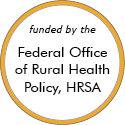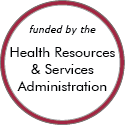Chronic Disease in Rural America – Models and Innovations
These stories feature model programs and successful rural projects that can serve as a source of ideas and provide lessons others have learned. Some of the projects or programs may no longer be active. Read about the criteria and evidence-base for programs included.
Effective Examples
Franklin Cardiovascular Health Program (FCHP)
Updated/reviewed March 2025
- Need: To develop sustainable, community-wide prevention methods for cardiovascular diseases in order to change behaviors and healthcare outcomes in rural Maine.
- Intervention: Local community groups and Franklin Memorial Hospital staff studied mortality and hospitalization rates for 40 years in this rural, low-income area of Farmington to seek intervention methods that could address cardiovascular diseases.
- Results: A decline in cardiovascular-related mortality rates and improved prevention methods for hypertension, high cholesterol, and smoking.
Community-Based Pulmonary Rehabilitation Program
Updated/reviewed January 2024
- Need: More evidenced-based chronic lower respiratory disease management options for rural Appalachia patients, where lung disease rates are among the highest in the country.
- Intervention: Implementation of outpatient pulmonary rehabilitation programs in 2 Federally Qualified Health Centers and a Critical Access Hospital in West Virginia.
- Results: Improved health outcomes for patients with chronic lower respiratory disease, including those with chronic obstructive pulmonary disease.
Promising Examples
TelePrEP
Updated/reviewed May 2025
- Need: To prevent new cases of HIV in rural Iowa.
- Intervention: TelePrEP provides preventive care via telehealth and prescription delivery.
- Results: Between February 2017 and August 2020, TelePrEP received 456 referrals, with 403 patients completing an initial visit.
Health without Borders


Updated/reviewed January 2025
- Need: To improve the health of communities in the south central region of New Mexico.
- Intervention: A program was developed to address diabetes prevention and control, behavioral healthcare, and immunization in Luna County.
- Results: During the program, 1,500 immunizations were distributed, baseline measurements of participants improved, and 935 new patients were seen for behavioral health issues.
Northeast Louisiana Regional Pre-Diabetes Prevention Program

Updated/reviewed March 2024
- Need: To prevent or slow the progression of diabetes for at-risk residents in Rural Northeast Louisiana.
- Intervention: The North Louisiana Regional Alliance developed a program that offered screenings, education, and an intense course for participants throughout the Northeast Louisiana region to lower the risk of diabetes.
- Results: The program saw an overall decrease in blood sugar levels in residents who participated in their initiatives.
Other Project Examples
COPD Readmission Prevention Program
Updated/reviewed August 2025
- Need: Organized focus on COPD patients' medical needs to decrease hospital readmissions in a rural Ohio healthcare system.
- Intervention: Creation of an integrated system model with nurse navigators central to evidence-based chronic disease care management approaches to COPD care.
- Results: Since its creation in 2014, the model continues to mature its comprehensive approach to provide optimized acute and chronic care for the area's COPD patients.
It's a Girl Thing: Making Proud Choices
Updated/reviewed June 2025
- Need: Teen pregnancy, sexually transmitted diseases, and mental health challenges in adolescent girls were concerns for members of Union Parish, Louisiana.
- Intervention: Union General Hospital, a Critical Access Hospital, created the program It's a Girl Thing: Making Proud Choices to teach prevention, self-confidence, personal responsibility, and mental well-being to teen girls.
- Results: Teen pregnancy rates in Union Parish have dropped by more than 40% since the start of the program, significantly exceeding the program's initial goal of 5%. Graduation rates have also increased. The addition of Together We Can Be Bully Free as an integral part of It's a Girl Thing has further expanded mental health support for participants.
Positively Living & Choice Health Network
Updated/reviewed May 2025
- Need: To provide affirming, destigmatized healthcare and support to thousands of Tennesseans living with HIV/AIDS, mental illness, substance use disorder, and homelessness – and prevention services for individuals at risk of contracting HIV.
- Intervention: Positively Living & Choice Health Network provides services including a medical clinic, pharmacy, therapy, case management, client services like housing aid and transportation, HIV prevention, and a harm reduction program.
- Results: The program currently serves 5,000 individuals and families through its offices in Knoxville, Chattanooga, Memphis, and Cookeville and its mobile medical unit for rural communities in Cocke and Claiborne counties.
Pacific AIDS Education and Training Center-Nevada

Updated/reviewed April 2025
- Need: To improve and increase prevention and care services for HIV, STDs, hepatitis C, and other infectious diseases.
- Intervention: PAETC-NV provides clinical and didactic trainings, conferences, technical assistance, capacity building, webinars, and other services to providers and healthcare organizations statewide.
- Results: In 2024, PAETC-NV trained more than 1,800 healthcare providers across Nevada to increase clinical capacity in the care, screening, and prevention of HIV, other sexually transmitted diseases, and hepatitis C.
University of Virginia Diabetes Tele-Education Program

Updated/reviewed March 2025
- Need: To educate people in rural Virginia who either have diabetes or are considered at high risk for developing it.
- Intervention: Teleconferencing technology is used to offer diabetes education programs to people with diabetes or those at high risk for developing it. Health professionals are also indirectly trained in diabetes care and management.
- Results: Participants reported better prevention practices and/or self-management of diabetes after being thoroughly educated about this condition.
Last Reviewed: 5/20/2022

